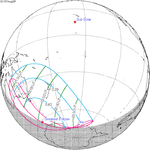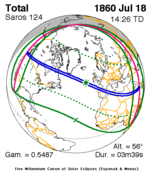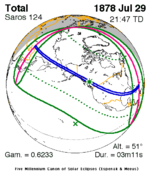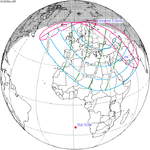A total solar eclipse occurred on September 22, 1968. A solar eclipse occurs when the Moon passes between Earth and the Sun, thereby totally or partly obscuring the image of the Sun for a viewer on Earth. A total solar eclipse occurs when the Moon's apparent diameter is larger than the Sun's, blocking all direct sunlight, turning day into darkness. Totality occurs in a narrow path across Earth's surface, with the partial solar eclipse visible over a surrounding region thousands of kilometres wide. Totality was visible from the Soviet Union (today's Russia and Kazakhstan) and Xinjiang in Northwestern China.
Observation
Soviet Union
A company named Opton proposed to the Sternberg Astronomical Institute to observe this solar eclipse in Sary Shagan on the west bank of Lake Balkhash, and also wrote to the Soviet Ministry of Railways for help to get to the destination faster. The observation team obtained spectrum of the corona. Students also assisted in taking pictures of the corona with MTO-1000 lens.[1]
China
This is the first total solar eclipse visible in the country since the founding of the People's Republic of China. It occurred during the Cultural Revolution, when astronomers including Zhang Yuzhe who organized observations of the total solar eclipse of June 19, 1936 and September 21, 1941 were excluded from key positions. The Chinese Academy of Sciences sent a team of 200 including Zhang Kuisan (张魁三), the then deputy director of the Geophysics Bureau to Xinjiang. The observation was code-named "532", named after the time February 1953 when Mao Zedong visited the Purple Mountain Observatory in Nanjing. The travel to Ürümqi by train first took 3 days, and another 7 days by car to the optical observation site Zhaosu Town (Mongolküre Town), Zhaosu County and the radio observation site Kashgar. Gravity measurements were also conducted in mountain caves. In order to avoid the turmoil of the Cultural Revolution, Zhou Enlai sent Liu Xiyao to lead the army to the local area and provide the whole team with meals and accommodation. The observation team completed the first monochromatic light observation and high-resolution radio observation of the sun in China. This was also the first time in China that a solar eclipse was observed by plane. Shanghai Scientific and Educational Film Studio also produced a science and education film of the total solar eclipse.[2][3]
The Soviet Union and China were the only two countries the path of this total solar eclipse passed. Due to the Sino-Soviet split, the two countries did not conduct any joint observations. About half a year after the eclipse, on January 23, 1969, the People's Daily published an article claiming that the observation of this eclipse "achieved brilliant results", repeatedly criticized the Soviet Union of "obstructing" it, and also mentioned that the Soviet Union "plundered data" of the annular solar eclipse of April 19, 1958.[4][5]
Related eclipses
Solar eclipses of 1968–1971
This eclipse is a member of a semester series. An eclipse in a semester series of solar eclipses repeats approximately every 177 days and 4 hours (a semester) at alternating nodes of the Moon's orbit.[6]
| Solar eclipse series sets from 1968 to 1971 | ||||||
|---|---|---|---|---|---|---|
| Ascending node | Descending node | |||||
| Saros | Map | Gamma | Saros | Map | Gamma | |
| 119 |  1968 March 28 Partial |
−1.03704 | 124 |  1968 September 22 Total |
0.94507 | |
| 129 |  1969 March 18 Annular |
−0.27037 | 134 |  1969 September 11 Annular |
0.22014 | |
| 139 |  1970 March 7 Total |
0.44728 | 144 |  1970 August 31 Annular |
−0.53640 | |
| 149 |  1971 February 25 Partial |
1.11876 | 154 |  1971 August 20 Partial |
−1.26591 | |
| A partial solar eclipse of July 22, 1971 occurs in the next lunar year set. | ||||||
Saros 124
Solar saros 124, repeating every about 18 years and 11 days, contains 73 events. The series started with partial solar eclipse on March 6, 1049. It contains total eclipses from June 12, 1211, to September 22, 1968, and a hybrid solar eclipse on October 3, 1986. The series ends at member 73 as a partial eclipse on May 11, 2347. The longest total eclipse occurred on May 3, 1734, at 5 minutes and 46 seconds.[7]
| Series members 43–59 occur between 1801 and 2100: | ||
|---|---|---|
| 43 | 44 | 45 |
 June 16, 1806 |
 June 26, 1824 |
 July 8, 1842 |
| 46 | 47 | 48 |
 July 18, 1860 |
 July 29, 1878 |
 August 9, 1896 |
| 49 | 50 | 51 |
 August 21, 1914 |
 August 31, 1932 |
 September 12, 1950 |
| 52 | 53 | 54 |
 September 22, 1968 |
 October 3, 1986 |
 October 14, 2004 |
| 55 | 56 | 57 |
 October 25, 2022 |
 November 4, 2040 |
 November 16, 2058 |
| 58 | 59 | |
 November 26, 2076 |
 December 7, 2094 | |
Tritos series
This eclipse is a part of a tritos cycle, repeating at alternating nodes every 135 synodic months (≈ 3986.63 days, or 11 years minus 1 month). Their appearance and longitude are irregular due to a lack of synchronization with the anomalistic month (period of perigee), but groupings of 3 tritos cycles (≈ 33 years minus 3 months) come close (≈ 434.044 anomalistic months), so eclipses are similar in these groupings.
| Series members between 1901 and 2100 | |||
|---|---|---|---|
 March 29, 1903 (Saros 118) |
 February 25, 1914 (Saros 119) |
 January 24, 1925 (Saros 120) | |
 December 25, 1935 (Saros 121) |
 November 23, 1946 (Saros 122) |
 October 23, 1957 (Saros 123) | |
 September 22, 1968 (Saros 124) |
 August 22, 1979 (Saros 125) |
 July 22, 1990 (Saros 126) | |
 June 21, 2001 (Saros 127) |
 May 20, 2012 (Saros 128) |
 April 20, 2023 (Saros 129) | |
 March 20, 2034 (Saros 130) |
 February 16, 2045 (Saros 131) |
 January 16, 2056 (Saros 132) | |
 December 17, 2066 (Saros 133) |
 November 15, 2077 (Saros 134) |
 October 14, 2088 (Saros 135) | |
 September 14, 2099 (Saros 136) |
|||
References
- ^ "Полное солнечное затмение 22 сентября 1968 г." Archived from the original on 3 January 2010.
- ^ "20世纪中国日全食观测小史". 16 July 2009. Archived from the original on 17 October 2020.
- ^ "《新闻调查》 19970314 寻踪日全食". China Network Television. Archived from the original on 10 July 2015.
- ^ "用毛泽东思想探索太阳的奥秘——记我国首次大规模日全食综合观测队". People's Daily. 23 January 1969.
一九五八年苏修打着"中苏日环食联合观测"的幌子,来我国掠取日环食资料。观测结束后,把一台破烂不堪的射电望远镜天线留在中国,还美其名曰"帮助中国发展射电天文学"。后来,赫鲁晓夫修正主义集团把这个破烂的射电望远镜天线也要了回去。
- ^ "我国大规模日全食综合观测取得辉煌成果". People's Daily. 23 January 1969.
- ^ van Gent, R.H. "Solar- and Lunar-Eclipse Predictions from Antiquity to the Present". A Catalogue of Eclipse Cycles. Utrecht University. Retrieved 6 October 2018.
- ^ Saros Series Catalog of Solar Eclipses NASA Eclipse Web Site.
External links
- Earth visibility chart and eclipse statistics Eclipse Predictions by Fred Espenak, NASA/GSFC
- Photos from solar eclipse of September 22, 1968 in USSR (Russian)




